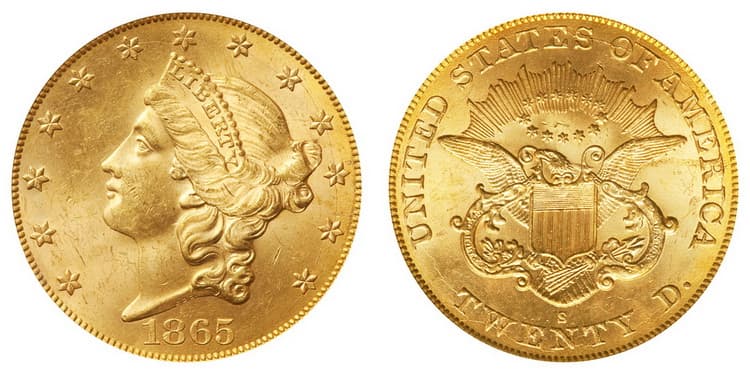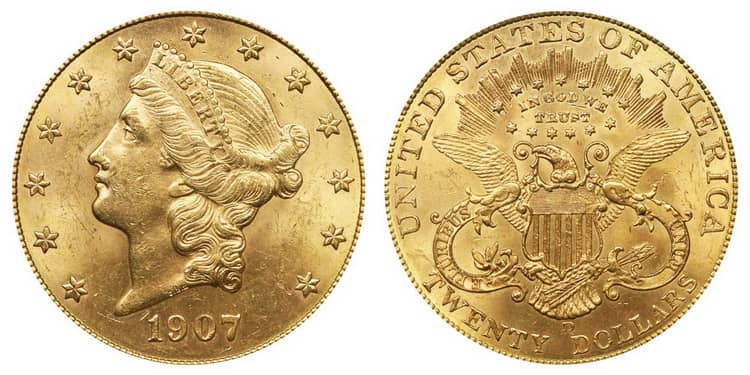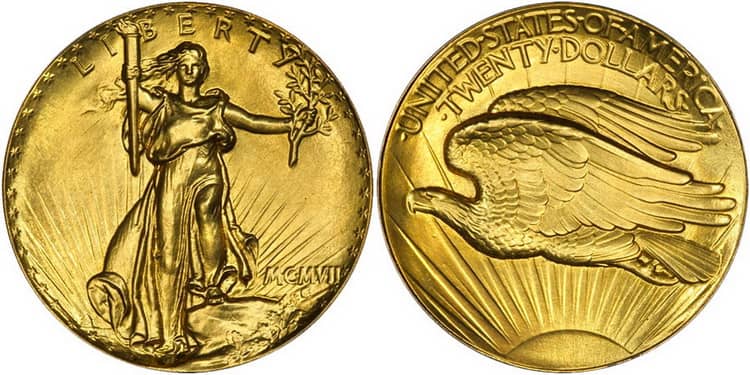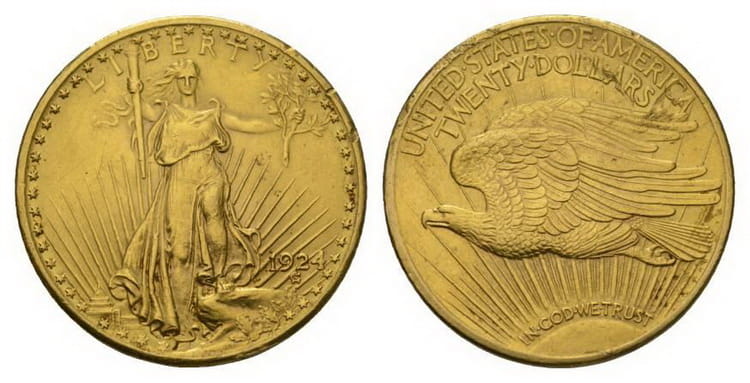
20 US dollars with the image of Liberty were minted between 1850 and 1933 and were represented by two main versions. Today, the gold coins of this denomination are the subject of interest for many numismatists and private collectors, since they are quite rare and expensive. You can find all US 20 Dollars gold coins in our catalog.
Gold coins with a face value of 20 US dollars
Coin «LIBERTY»
The first version (1850-1866)
- Obverse: profile of a woman, symbolizing freedom, wearing a headband with an inscription «LIBERTY» on it; decorative ornament and thirteen stars; year of minting at the bottom from 1849 to 1907.
- Reverse: decorative ornament; inscription «UNITED STATES OF AMERICA»; denomination «TWENTY D.»; bald eagle with a shield on the chest, arrows and a laurel twig in its clutches, and a symbolic ribbon with the inscriptions “EPLURIBUS” and “UNUM” in its beak; oval thirteen stars in rays of the sun above the head of the eagle.
- Edge: reeded
- Composition: 90 % Au + 10 % Cu
- Weight: 33.44 g
- Diameter: 34 mm

The second version (1866-1876)
- Obverse: profile of a woman, symbolizing freedom, wearing a headband with an inscription «LIBERTY» on it; decorative ornament and thirteen stars; year of minting at the bottom from 1849 to 1907.
- Reverse: decorative ornament; inscription «UNITED STATES OF AMERICA»; denomination «TWENTY D.»; bald eagle with a shield on the chest, arrows and a laurel twig in its clutches, and a symbolic ribbon with the inscriptions “EPLURIBUS” and “UNUM” in its beak; oval of thirteen stars with the inscription «IN GOD WE TRUST» in rays of the sun above the head of the eagle.
- Edge: reeded
- Composition: 90 % Au + 10 % Cu
- Weight: 33.44 g
- Diameter: 34 mm

Third version (1877-1907)
- Obverse: profile of a woman, symbolizing freedom, wearing a headband with an inscription «LIBERTY»; decorative ornament and thirteen stars; year of minting at the bottom from 1849 to 1907.
- Reverse: decorative ornament; inscription «UNITED STATES OF AMERICA»; denomination «TWENTY DOLLARS»; bald eagle with a shield on the chest, arrows and a laurel twig in its clutches, and a symbolic ribbon with the inscriptions “EPLURIBUS” and “UNUM” in its beak; oval of thirteen stars with the inscription «IN GOD WE TRUST» in rays of the sun above the head of the eagle. The denomination has been changed from “TWENTY D.” to “TWENTY DOLLARS”.
- Edge: reeded
- Composition: 90 % Au + 10 % Cu
- Weight: 33,44 g
- Diameter: 34 mm

US 20 Dollars 1882 in our catalog of gold coins.
American gold eagle coin of 1907-1933
- Obverse: woman symbolizing freedom; inscription «LIBERTY» above her head; burning torch and laurel twig in her hands; stars around the edge; year of minting in Roman numerals at the very bottom (after 1909 in Arabic numerals).
- Reverse: inscription «UNITED STATES OF AMERICA» and denomination «TWENTY DOLLARS» at the top; bald eagle on the foreground of rays of the rising sun; inscription «IN GOD WE TRUST» appears after 1909.
- Edge: reeded.
- Composition: 90 % Au + 10 % Cu
- Weight: 30,0933 g
- Diameter: 34 mm
The first version (1907-1908)

The first version (1909-1933)

20 Dollars 1927 US gold coin in our catalog.
What these coins were minted for
The issue of twenty-dollar gold coins in 1849 was preceded by the so-called “gold rush”. The massive opening and development of new gold mines led to a massive influx of prospectors. They created tent camps and even small settlements near them. It all contributed to the development of the country’s economy, replenishment of the gold reserve and minting of gold coins of new denominations.
Later, in 1907, the American President Theodore Roosevelt decided to change the design of these coins and assigned the development of sketches to the famous architect August Saint-Gaudens. It was this coin that became the prototype for a series of coins “American Golden Eagle”.
Mints and circulations
Out of five mints of the United States of America, Philadelphian was the largest by the number of emissions. The rest mints minted smaller quantities of coins. However, the coins of 1850-1907 had mint marks on the reverse:
- San Francisco – “S”;
- New Orleans – “O”;
- Denver – “D”;
- Carson City – “CC”.
All these mints issued 20 dollars coins from gold at some point. Philadelphia was minting them during the entire period from 1849 to 1907 until the US government withdrew them from circulation.
| Mint | Periods of minting | Approximate circulation (pcs.) |
| Philadelphia | 1849-1907 | 1,500,000 |
| Carson City | 1870-1879;
1882-1885; 1889-1893. |
100,000 |
| Denver | 1906-1907 | 850,000 |
| New Orleans | 1850-1861;
1879 |
315,000 |
| San Francisco | 1854-1885;
1887-1907. |
2,600,000 |
The coins of Saint-Gaudens also had the mint marks:
- San Francisco – «S»;
- Denver – «D».
They were issued in circulations, which are given in the table:
| Year of minting | Total circulation (pcs.) |
| 1907 | 372,917 |
| 1908 | 5,463,059 |
| 1909 | 2,988,640 |
| 1910 | 3,039,250 |
| 1911 | 1,819,500 |
| 1912 | 149,750 |
| 1913 | 596,280 |
| 1914 | 2,046,250 |
| 1915 | 719,500 |
| 1916 | 796,000 |
| 1920 | 786,250 |
| 1921 | 528,500 |
| 1922 | 4,033,500 |
| 1923 | 2,268,250 |
| 1924 | 10,300,500 |
| 1925 | 9,546,750 |
| 1926 | 3,339,250 |
| 1927 | 6,233,750 |
| 1928 | 8,816,000 |
| 1929 | 1,779,750 |
| 1930 | 74,000 |
| 1931 | 3,044,750 |
| 1932 | 1,101,750 |
| 1933 | 445,500 |
The new online CSS cleaner website allows you to organize style for websites.
Design
If you look carefully at the gold coins of 20 dollars of 1850-1907, you can see several changes that were made in the design of the reverse. It is worth noting that the obverse has always remained unchanged. Until 1877, the sketches were developed by the engraver James Barton Longker, who was known in America as a magnificent portraitist. During his work on these coins, there was only one change in design made. In 1866, the phrase “IN GOD WE TRUST” was placed on the reverse. After 1877, the design of coins was developed by the engraver Charles Barber. During the period of his work, the denomination was indicated in full.
Similar changes have affected the Golden Eagle issue of 1907-1933 with August Saint-Gaudens design. The famous phrase “IN GOD WE TRUST” appeared on these coins only in 1909. Also, that year Roman numerals were replaced by Arabic numerals.
Cost on the market
There is a fairly small number of gold twenty-dollar coins of 1850-1907 that survived, so their value on numismatic exchanges and auctions is very high and at times exceeds their nominal value. It is worth paying attention to what mint produced these coins, since the circulations in Carson City and New Orleans were minimal, and they were also subjected to partial melting down. The price of such coins will reach two tens of dollars (Цена таких монет из-за их редкости будет достигать двух десятков долларов) because of their rarity. For example, the coin of 1886 reaches 22,500 dollars in price. The coins of the Philadelphia mint of 1875, 1877 and 1904 will cost about 1,184.72-1,237.66 US dollars. Another rare type of these coins was issued in 1870 by the mint in Carson City. The circulation was 3,789 copies. In March 2009, at the international auction, one coin of this circulation was sold for a fabulous sum of $ 414,000. However, the sum of $ 161,000 broke all the records. In August 2006, at the auction, it was paid for a coin of 1861 issued by the Philadelphia mint. All US gold coins in our catalog.
Besides the rarity of 20 US dollars gold coins, their condition at the time of purchase/sale is an important characteristic, as it’s shown in the photo:
- VERY FINE;
- EXTREMELY FINE;
- ABOUT UNCIRCULATED.
The Golden Eagle coins of 1907-1933 can be purchased at numismatic exchanges and auctions at a price from 1,650 to 2,450 US dollars.
Interesting facts
-
- On March 3, 1865, when the US Civil War was coming to an end, the US Congress adopted an act to write the phrase “IN GOD WE TRUST” on the reverse of gold and silver dollars. By this gesture, the government decided to express its support to citizens who lost loved ones during the war.
- It is known that one of two gold twenty-dollar coins of 1849 was saved. Today it is stored in the National numismatic collection of the United States of America.
- In 1933, the US President Franklin D. Roosevelt withdrew gold coins of this denomination from circulation entirely and sent them abroad for international banking operations and melting down and storage in European bank safes. Many of them were returned to their homeland in order to meet the demand of collectors and those who want to invest their savings in gold.
- Today, there are no more than 20 gold coins in the world with a face value of 20 dollars of the issue of 1877.
- Millions of gold coins with a face value of 20 US dollars were sent to Europe as payment for international transactions, beginning in the 1880s, packed in cloth bags containing 250 coins of 5,000 US dollars per bag in total.
Comments
No commens yet.